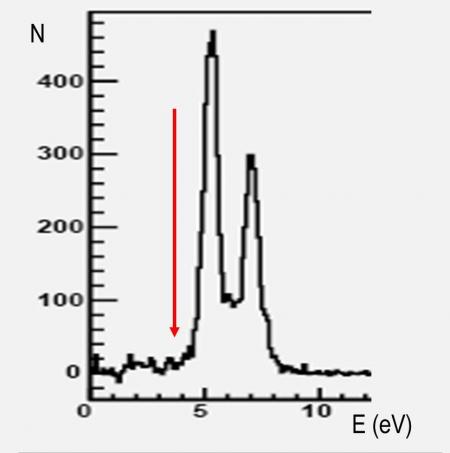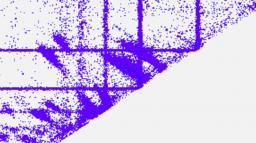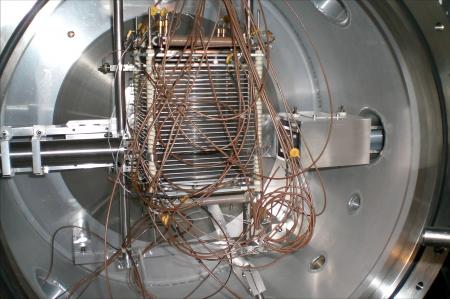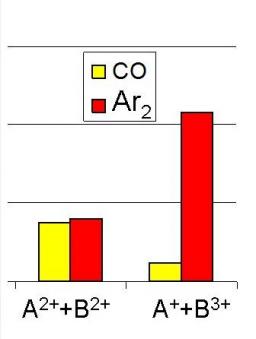

A. Cassimi, D. Hennecart, J. Rangama, T. Been, D. Lelièvre, J.-M. Ramillon, - CIMAP, CEA-CNRS, Caen,
T. Muranaka CEA-IRFU Saclay
A. Leredde, X. Fléchard, LPC
H. Shiromaru, J. Matsumoto, K.-I. Hayakawa Tokyo Metropolitan University
|
By exploring matter with energetics ions, the charge distribution between the ionic fragments, informs us about the nature of atomic bonds. It has thus been observed that the charge induced by ionisation is more evenly distributed between the fragments in the case of covalent molecules, where the electrons are delocalized over all atoms, compared to rare gas clusters, where electrons remain localized on their individual atom. |
Removing several electrons from a polyatomic structure, such as a molecule or a cluster of atoms, usually leads to its dissociation. Indeed, the cohesion of these systems results from the exchange of electrons between the constituent atoms. Removing some of these electrons destabilizes the bonds in the atomic structure, which dissociates upon relaxation. This includes molecules with covalent bonds or, even more delocalized, metallic clusters.
The delocalized state of the electrons is shown by the dominant fragmentation channels in the dissociation of such objects after a multi-ionization, where the charge deficit tends to be evenly distributed on the fragments. Thus, for a diatomic molecule (N2 or CO for example), the paths leading to the production of atomic fragments of equal charges will always be preferred. For the very same reasons, the fragmentation of large size clusters (C60, Nan, ...) leads mainly to singly charged fragments.
These questions are legitimate, since it is also shown that the mobility of charges is an important factor conditioning the susceptibility of materials to irradiation. Thus, damages depend heavily on their character of conductor or insulator.

Kinetic energy distribution (in eV) of the Ar+ fragments. The arrow indicates the expected energy for a separation after rapid redistribution of the electrons on the two atomic centers.
The role of the mobility of charges in simple molecular systems has been investigated by a Franco-Japanese collaboration, including the CIMAP group. The study focused on clusters of rare gas consisting of only a few atoms. These aggregates, weakly linked by van der Waals interactions (i.e. dipole-dipole interaction) are produced in a supersonic beam. The soft ionization without any transfer of vibrational energy is obtained very efficiently by collisions with multiply charged ions of low energy (Ar9+ at 152 keV), provided by the ARIBE beam line in GANIL. The rapid passage of the multicharged ion, close to the target, induces the ionization by capture of outer electrons (ie valence e-).
The details of the fragmentation dynamics (by relaxation of the system) and the measure of the charges have been obtained by the spectrometer COLTRIMS (Cold Target Recoil Ion Momentum Spectroscopy) of CIMAP. This device uses imaging techniques, time of flight measurements and multi-coincidence detection (Figure 1). It gives access to the number of electrons extracted from the system during the collision, the identification of each fragment (charge and mass) together with the measurement of their kinetic energy after the "explosion" of the cluster.
In this context, the recent study of the fragmentation of argon dimers (Ar2) led to a surprising observation: the kinetic energy of the fragments is higher than the expected value for dissociation into two fragments with the same charge (Fig. 2). Instead, the measured values show that the electrons are pulled out from only one of the two atoms. Then the system dissociates by an excimer process (specifically a donor-acceptor complex process). This localization of the charge reflects the low electron mobility in the system and is also observed on the relative statistical weight of the different fragmentation channels (Figure 3). In the case of Ar24+, the asymmetric channel (Ar+ + Ar3+) is dominant whereas it is only around 10% of the symmetric channel, for covalent systems (N24+ → N2+ + N2+).
References:
"Asymmetry in Multiple-Electron Capture Revealed by Radiative Charge Transfer in Ar Dimers",
J. Matsumoto, A. Leredde, X. Fléchard, K. Hayakawa, H. Shiromaru, J. Rangama, C. L. Zhou, S. Guillous,
D. Hennecart, T. Muranaka, A. Mery, B. Gervais, and A. Cassimi,
Physical Review Letters, 105 (2010) 263202.
"Charge mobility in rare gas clusters",
J.Matsumoto, A.Leredde, K.Hayakawa, H.Shiromaru, X.Flechard, J.Rangama, D.Hennecart, T.Muranaka, A.Cassimi, 21st International Symposium on "Ion-Atom Collisions" (ISIAC), July 17-20, 2009, Norfolk, Virginia, USA.
Other references about molecular dissociation:
"Internal inelastic scattering satellite probed by molecular-frame photoelectron angular distributions from CO2",
X.-J. Liu, H. Fukuzawa, T. Teranishi, A. De Fanis, M. Takahashi, H. Yoshida, A. Cassimi, A. Czasch, L. Schmidt, R. Dörner, I. Koyano, N. Saito, and K. Ueda, Phys.Rev.Lett. 101 (2008) 023001
"Breakdown of the two-step model in K-shell photoemission and subsequent decay probed by the molecular-frame photoelectron angular distributions of CO2",
X.-J. Liu, H. Fukuzawa, T. Teranishi, A. De Fanis, M. Takahashi, H. Yoshida, A. Cassimi, A. Czasch, L. Schmidt, R. Dörner, K. Wang, B. Zimmermann, V. McKoy, I. Koyano, N. Saito, and K. Ueda, Phys.Rev.Lett. 101 (2008) 083001
"Ionization and fragmentation of water clusters by fast highly charged ions",
L Adoui, A Cassimi, B Gervais, J-P Grandin, L Guillaume, R Maisonny, S Legendre, M Tarisien, P López-Tarifa, M-F Politis, M-A Hervé du Penhoat, R Vuilleumier, M-P Gaigeot, I Tavernelli, M Alcamí and F Martín, J.Phys.B: At. Mol. Opt. Phys. 42 (2009) 075101.














